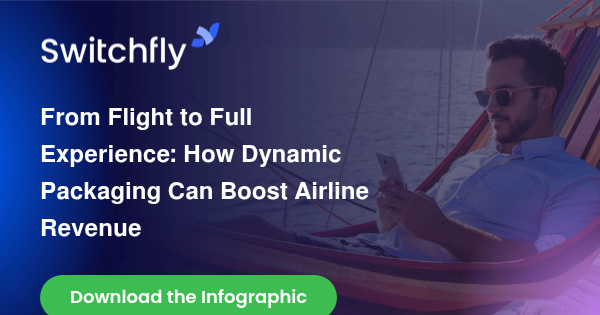
Price may dominate consumer search behavior, but it no longer defines customer loyalty, nor long-term profitability. In an aviation landscape increasingly pressured by commoditization, the airlines that win aren’t the ones offering the lowest fares. They are the ones delivering the most meaningful airline customer experience. Travelers rarely remember the exact amount they paid, but they always remember how a journey made them feel.
And as fare parity continues to flatten differences between airlines, experience—not economics—is emerging as the most powerful lever of airline differentiation. Modern travel technology, personalization, and dynamic packaging are accelerating this shift by helping airlines compete on value instead of volatility.
Why Airlines Can’t Compete on Price Anymore (and What To Do Instead)
Competing on price has long been treated as an unavoidable reality in aviation, but the economics simply don’t support it. According to IATA, airlines earn only about $7 per passenger on average. When profitability is that limited, a price-first strategy quickly becomes a race to the bottom—one that erodes brand equity, squeezes financial performance, and dilutes customer trust.
Commoditization has made it harder for airlines to differentiate on fare alone. Aggregators reinforce the perception that all seats are equal. Meanwhile, traveler expectations have evolved well beyond the lowest price point. Today's passengers expect mobile-first convenience, personalized communication, recognition throughout the journey, and loyalty experiences that reflect their lifestyle.
Lowest fare may influence the search, but it no longer creates loyalty. This is where experience emerges as the differentiator.
Experience-Led Airline Differentiation
As fares flatten across the industry, experience has become the new battleground. And while elevating the travel journey was once considered an operating expense, it is now proving to be a profit center—one that drives retention, share of wallet, and long-term loyalty.
Service as Strategy
Service excellence is no longer about reactive hospitality. Today’s leading carriers use:
-
Proactive service recovery
-
Personalized, high-touch in-flight experiences
-
Loyalty tier recognition that feels meaningful
-
Real-time communication powered by AI
These touchpoints help airlines deliver consistency and care in ways travelers immediately feel. When passengers sense that an airline “knows” them—through tailored content, recommendations, and offers—price stops being the primary decision filter.
Building Emotional Loyalty
Transactional loyalty can be bought. Emotional loyalty must be earned.
Research shows that emotionally connected customers often have a higher lifetime value than those who participate in loyalty programs solely for rewards. Airlines that humanize travel—infusing empathy, consistency, and care—create a bond that not only endures but also supports premium pricing.
In other words, customers don’t just stay—they choose you.
The Power of Full-Journey Experiences
Travelers no longer see airlines as just a means of transportation. Increasingly, they see them as trip curators—brands that should support their entire travel journey, not just the portion spent in the aircraft. This is where extending the value proposition beyond the seat becomes crucial.
Dynamic packaging transforms airlines into lifestyle brands by bundling flights, hotels, car rentals, and activities into a single, seamless booking path. It deepens the relationship with the traveler, introduces new loyalty touchpoints, and significantly expands revenue potential.
Industry data underscores the opportunity: ancillary revenues now comprise 15–20% of total airline income, demonstrating that value beyond the fare is no longer optional—it’s essential.
Seamless Booking as a Differentiator
A frictionless, unified booking experience matters more than ever. When a traveler can secure their entire trip with one confirmation from a trusted airline brand, the perceived value skyrockets. Pair that with the ability to earn and redeem loyalty currency across packaged experiences, and the airline becomes the traveler’s preferred planning partner.
Loyalty as the Lever to Break the Price Trap
Loyalty is one of the most powerful tools airlines have to escape the price trap. Passengers don’t stay with a carrier because flights are marginally cheaper; they stay because they feel recognized, rewarded, and understood.
Dynamic earn and burn opportunities—especially when tied to lifestyle and traveler goals—elevate perceived value and dramatically increase redemption activity. When loyalty integrates with dynamic packaging, the effect compounds: engagement rises, ancillary revenue expands, and the airline becomes part of the traveler’s everyday decision-making ecosystem.
Loyalty, in this context, stops being a cost center. It becomes a value engine.
How Travel Technology Powers Airline Differentiation
Technology now dictates the pace of competition. Customer expectations evolve quickly, and the airlines that respond quickly are the ones that maintain relevance.
Modular platforms like Switchfly help airlines:
-
Launch packaging solutions in as little as 90 days
-
Integrate loyalty, points redemption, and dynamic earn/burn
-
Personalize offers without recreating legacy systems
-
Add new capabilities without a costly rebuild
Speed to market has become a strategic advantage. Airlines no longer need to spend years building connectors, managing ongoing API maintenance, or reinventing infrastructure. With modern travel technology, airlines can finally compete on experience at scale.
The Future of Airline Differentiation
Price will always influence purchase decisions—but it will not define the future of airline competition. The carriers that stand out will be those that think like travel brands rather than transportation providers. They will win by focusing on experience, personalization, emotional loyalty, and ecosystem thinking.
The next generation of airline leaders will invest in value, not volatility, and Switchfly is helping them get there.
See how top airlines grow without lowering fares: Download our Dynamic Packaging Infographic.
By focusing on seamless digital interactions, loyalty recognition, and personalization across the entire travel journey.
Thin margins, around $7 per passenger, make fare-based competition unsustainable. Experience, differentiated offerings, and loyalty create far stronger long-term value.
Yes. Airlines that package hotels, cars, and experiences generate higher ancillary revenue and stronger loyalty engagement.
Loyalty-driven personalization and dynamic earn and burn create emotional stickiness, which passengers value more than small fare differences.




